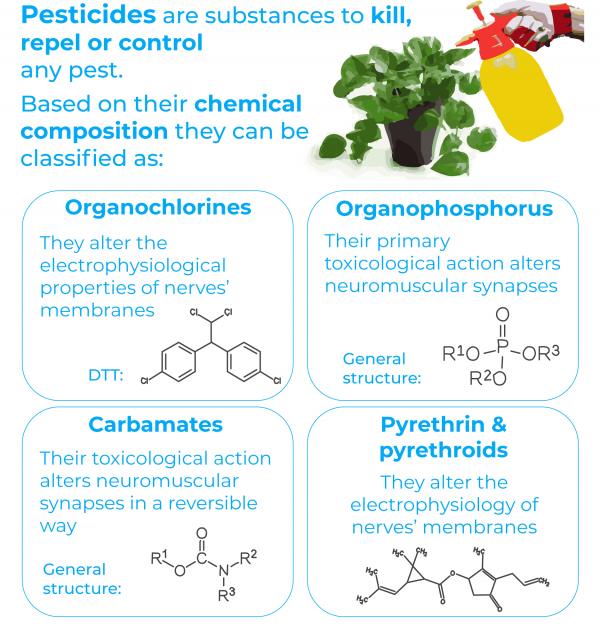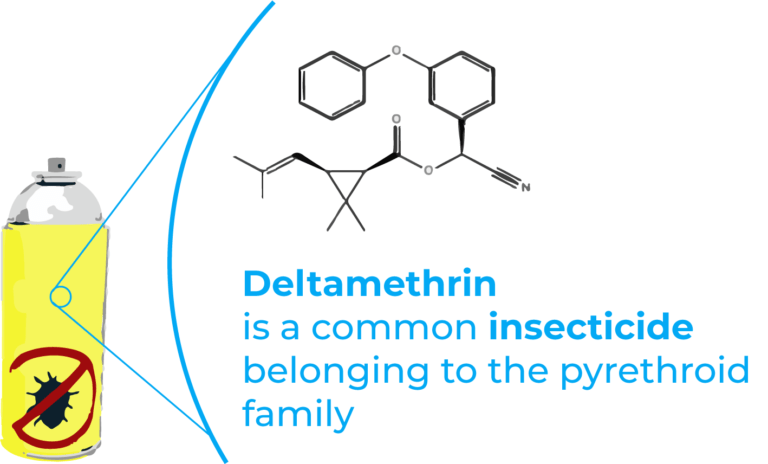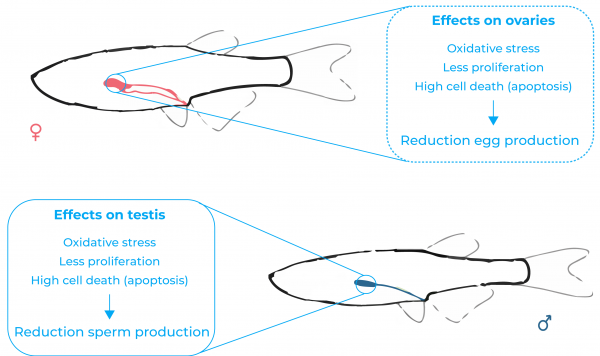Since 1974, World Environment Day has been celebrated every year on 5 June, so this month we want to acknowledge this event by reviewing a scientific article where zebrafish are used to test the toxicity of certain pesticides: Toxicity of Deltamethrin to Zebrafish Gonads Revealed by Cellular Biomarkers 1, published in Journal of Marine Science and Engineering on January 23th, 2020.
This article investigates the chronic effects of deltamethrin, a synthetic insecticide extensively used in pest control, on gonads. For doing so, the authors of the mentioned article exposed zebrafish adults to different non-lethal concentrations of deltamethrin and studied cell death and proliferation and oxidative stress in the gonads.
Pesticides: classification, toxicity, and importance
Pesticides are defined as any substance used to kill, repel, or control certain forms of plant or animal life that are considered to be pests2. This definition includes a wide range of compounds including insecticides, fungicides, herbicides, rodenticides, molluscicides, nematicides, plant growth regulators and others.
Ideally, pesticides must be lethal to the targeted pests, but not to non-target species, including man. Unfortunately, this is not the case, so the controversy of use and abuse of pesticides has surfaced, leading to a greater demand for toxicity data.
Several classifications have been proposed based on various criteria. Most commonly used criteria for classification of pesticides are their mode of entry, their chemical composition and the targets they kill. Besides, World Health Organization (WHO) and Globally Harmonized System (GHS) have classified pesticides according to their toxicity or hazardous effects3.

Here, we will present the classification based on pesticide’s chemical composition, since it is the most common and useful method of classifying them. In general, modern pesticides are organic chemicals, including both from synthetic and plant origins, but some inorganic compounds can also be used as pesticides. Based on chemical composition, pesticides are classified into four main groups:
Organochlorine pesticides are chlorinated hydrocarbons used extensively in agriculture and mosquito control. Although these compounds were widely used in the 1940s in, they were banned in developed countries in the 1970s because of their high persistence in the environment and their harmful effects in human health4. Organochlorine pesticides are more persistent in the environment than most other synthetic organic pesticides.
The major toxic action is on the nervous system since they alter the electrophysiological properties of the cell membranes (particularly nerve axons)5. Representative compounds of organochlorines include DDT, methoxychlor, dieldrin, chlordane, lindane, and benzene hexachloride.
Organophosphorus (or organophosphate) pesticides (OP) constitute a diverse group of chemical structures exhibiting a wide range of physicochemical properties, with a central phosphate molecule with alkyl or aromatic substituents6. They are the most widely used pesticides in the United States for both agricultural and residential application. Approximately 80 million pounds of OP pesticides are used annually in the United States, with 75% of their use in agriculture7.
Their primary toxicological action arises from inhibition of the enzyme acetylcholinesterase, an enzyme that is found in neuromuscular synapses where it helps to terminate with the synaptic transmission6. In this way, when used as an insecticide, the insects die with their muscles in a prolonged state of contraction and their nervous system in a state of sustained excitation. However, this enzyme is not exclusive of insects, but it is essential for most animal species, including humans. As a result, these pesticides are potentially toxic to a wide variety of non-target species.
Some examples are parathion, malathion, chlorpyrifos and diazinon.
Carbamates pesticides are structurally and mechanistically similar to organophosphate pesticides, since they also inhibit the action of the enzyme acetylcholinesterase, but in a reversible way 8. Carbamates derive from carbamic acid and are commonly used as insecticides, although some compounds are also used as herbicides. They are normally used on crops, and at home to kill cockroaches, ants, fleas, crickets, aphids, scale, whitefly, lace bugs and mealy bugs.
Common agents resulting in toxic exposure are aldicarb, carbofuran, carbaryl, ethinenocarb, fenobucarb, oxamyl, methomyl, pirimicarb, propoxur, and trimethacarb.
This class of pesticides includes two types of compounds: pyrethrins, which are compounds obtained from chrysanthemum flowers, and pyrethroids, which are synthetic analogs of pyrethrins9.
The molecular targets of the pyrethrins and pyrethroids are similar in mammals and insects. They alter the electrophysiological properties of the cell membranes (particularly nerve axons)9. However, mammals are less susceptible to these compounds than insects primarily because they have a faster metabolic clearance, higher body temperatures and a lower affinity for the pyrethrins/pyrethroids.
Deltamethrin, a broad-spectrum insecticide
Deltamethrin is an insecticide belonging to the pyrethroid family. It is used outdoors on lawns, ornamental gardens, golf courses, and indoors as a spot or crack and crevice treatment. It has been in the market since 1978 and it can be found in different forms, such as aerosols, sprays, dusts, granules and wettable powders10.

Humans can be exposed to deltamethrin if they touch, eat or breath in it (for example, if a fine mist or dust containing deltamethrin gets in the air you breath). When deltamethrin gets on the skin it can cause irritation that usually goes away within 48 hours. And if breathed in, it can cause headaches and dizziness10.
In the environment, the highest concentrations of deltamethrin have been found in dust samples from residential areas in Berlin and in river sediments in Vietnam11.
Regarding the effects of deltamethrin in aquatic ecosystems, negative effects have been found under laboratory conditions in different freshwater species: crucian carp, chinese mitten crab, silver carp, brown trout, and zebrafish1.
Zebrafish to study deltamethrin toxicity
Zebrafish is an excellent tool to study the mechanisms of pesticide toxicity and the alterations they induce in aquatic organisms. As a toxicological model, zebrafish have the potential to reveal the pathways of toxicity due to the similarities of its molecular pathways and physiology to that of humans.
Several studies have shown the effects of deltamethrin in zebrafish. With some of these effects being: development retardation, chorion surface tension reduction, larvae malformations (such as body axis curvature), pericardial oedema, developmental neurotoxicity, swimming speed and depth alteration, and inhibition of acetylcholinesterase1.
Besides, it has been shown that chronic exposure to this compound can cause reproductive impairment in zebrafish1. However, the mechanisms underlaying this effect are quite unknown. For this reason, the authors of the reviewed study aimed to complete the image of the lesions produced by deltamethrin responsible of this reproductive impairment by exploring the effects of this pesticide on the zebrafish gonads: testis and ovaries.
Effects of deltamethrin on zebrafish gonads
In order to study the effects of deltamethrin on the zebrafish gonads, what the authors of the study did was to expose zebrafish adults for 15 days to non-lethal concentrations of this compound. After 15 days of exposure, they studied the histology of the gonads, as well as cell death, cell proliferation and oxidative stress in these organs1.

In both, ovaries and testis, they observed changes in the tissue of these organs. Moreover, in ovaries, they determined that the exposure to deltamethrin was related to a reduction in egg production and, in testis, to a progressive diminution of the spermatocysts containing spermatocytes and spermatids. Thus, this insecticide has a significant negative effect on the correct functioning of the zebrafish gonads1.
On the other hand, they studied several markers related to cell death, cell proliferation and oxidative stress in the zebrafish gonads. They evidenced that the decreased egg and sperm production could be explained by lower levels of cell proliferation, and higher levels of apoptosis, a type of cell death1.
Conclusion
This study evaluates the gonadotoxicity effects of deltamethrin in zebrafish adults and shows that deltamethrin affects egg cell and sperm production, pointing out a negative effect of this compound over the reproduction function.
Understanding the effects and mechanisms of action of insecticides, and all kind of pesticides, is of great importance since it can help to design more specific substances to reduce the non-desired non-target effects.
References
- Petrovici A. et al. (2020) Toxicity of Deltamethrin to Zebrafish Gonads Revealed by Cellular Biomarkers. Journal of Marine Science and Engineering. https://doi.org/10.3390/jmse8020073
- Pesticides (NIH). Retrieved June 23, 2021. https://www.niehs.nih.gov/health/topics/agents/pesticides/index.cfm
- The WHO Recommended Classification of Pesticides by Hazard and guidelines to classification, 2019 edition (WHO). Retrieved June 23, 2021. https://www.who.int/publications/i/item/9789240005662
- Karasali H., Maragou N. (2016) Pesticides and Herbicides: Types of Pesticide, Encyclopedia of Food and Health, Academic Press, Pages 319-325, https://doi.org/10.1016/B978-0-12-384947-2.00535-3
- Coats J. R. (1990) Mechanisms of toxic action and structure-activity relationships for organochlorine and synthetic pyrethroid insecticides. Environmental health perspectives. https://doi.org/10.1289/ehp.9087255
- Frequently asked questions about Organophosphates (CDC). Retrieved June 23, 2021 https://www.cdc.gov/nceh/clusters/fallon/organophosfaq.htm
- Miodovnik A. (2019) Front Matter of Volume 5, Encyclopedia of Environmental Health (Second Edition), Elsevier, Page iii, https://doi.org/10.1016/B978-0-444-63951-6.01005-6
- R.C. Gupta (2014) Carbamate Pesticides, Encyclopedia of Toxicology (Third Edition), Academic Press, Pages 661-664, https://doi.org/10.1016/B978-0-12-386454-3.00106-8
- Ensley S. M. (2018) Chapter 39 – Pyrethrins and Pyrethroids, Veterinary Toxicology (Third Edition), Academic Press, Pages 515-520, https://doi.org/10.1016/B978-0-12-811410-0.00039-8
- Deltamethrin – General Fact Sheet (NPIC). Retrieved June 23, 2021. http://npic.orst.edu/factsheets/DeltaGen.html
- Tang W. et al. (2017) Pyrethroid pesticide residues in the global environment: An overview. Chemosphere, https://doi.org/10.1016/j.chemosphere.2017.10.115



